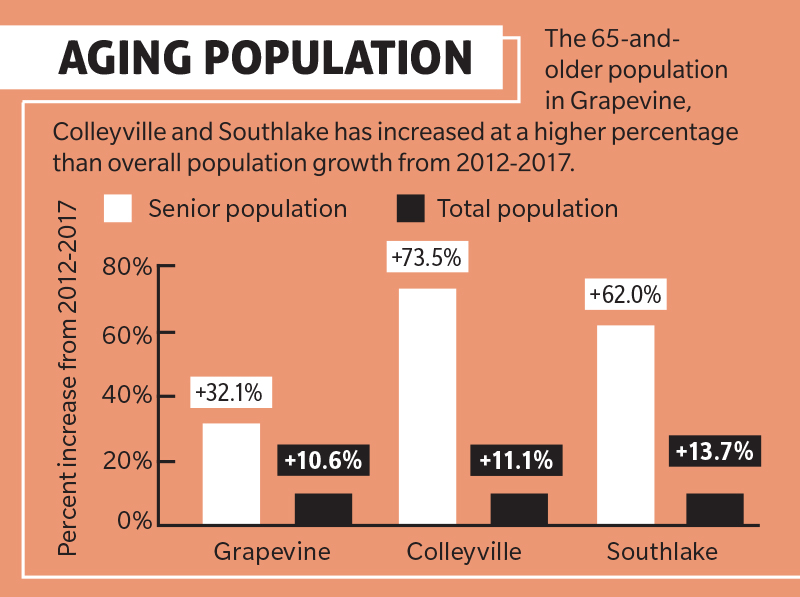Colleyville and Southlake have higher housing costs and fewer options for smaller homes, apartments and senior living facilities compared with their neighbors, but that is not keeping older residents away.
The senior population grew at a faster pace than the populations of those cities as a whole. Between 2012-17, Colleyville’s population increased 11.1 percent, according to data released in December by the American Community Survey for the U.S. Census Bureau. During that same period, the percentage of residents age 65 and older increased 73.5 percent.
In Southlake the population increased 13.7 percent during that six-year period while the number of seniors grew by 62 percent, records show.
The percentage of the senior population is also growing in Grapevine, where housing costs are lower compared with Southlake and Colleyville. Grapevine’s population went up 10.6 percent between 2012-17. At the same time, the number of seniors increased by more than 32 percent, the data shows.
Seniors as a whole are still a small part of Grapevine, Colleyville and Southlake’s overall population, but their numbers are growing in part because of longer life expectancies, according to the National Center for Health Statistics.
Retiree Frank Allen said he settled in Southlake because it was close to his family and convenient for traveling.
“It had all the things we wanted: access to a hub airport, quality shopping for most needs, a walkable downtown and the arts,” he said in an email. “We do not like 100-plus [temperatures], so we tend to travel internationally or domestically, often in July and August.”
He called downsizing “overrated.” His first retirement home in Colleyville was fine, he said, but too small for his needs. He eventually upsized and moved to Southlake.
“The larger home allowed us to invite friends and relatives from Minnesota to come down,” he said. “This house is great for entertaining.”
Lack of small homes
MIG Real Estate Realtor Theresa Mason said retirees who come to her with their living needs are often looking to downsize.
“In some cases, then, it does make sense for them to stay in these areas because they’re used to paying more for what they’ve got,” Mason said. “They can still be in the area but live in something a little bit smaller.”
People who choose to retire younger should be cautious owning a home since rising property values can create financial challenges in cities that do not offer a tax freeze for seniors.
“Across the state property taxes will go up, but in [Colleyville and Southlake] they can get pretty high,” she said.
But that does not stop people from retiring there. About 15.9 percent of Colleyville’s population is 65 and older, according to 2017 data from the American Community Survey. The percentage of people 65 and older living in Grapevine and Southlake is 9.3 percent and 8.8 percent, respectively.
Colleyville Mayor Richard Newton said he has seen more seniors age in place—he is among them. A growing senior population in a city is a good thing, he said.
“People are our biggest, No. 1, resource,” he said. “Not just the retirees but all of them. We have great, highly educated people with tons of experience in any area that you can name and senior level of experience, so they have a lot of experience, a lot of expertise, a lot of education and a high willingness to get involved because they do care about the city, too.”
Options limited
The growth in older residents comes despite limited options for affordable housing in those cities.
Data from the 2016 American Community Survey shows the median home price in Southlake is 129 percent more than Grapevine’s median home price. In Colleyville, the median home price is 67 percent more than in Grapevine.
In addition, Colleyville has no independent-living facilities for seniors, according to ApartmentData.com, which tracks those facilities in the Dallas area.
Southlake has three senior living facilities. Their average monthly rent is $4,035 as of November, according to the data.
That compares with Grapevine, which has four senior living facilities with an average monthly rent of $1,953.
“There are some great localities right next door in Keller, North Richland Hills, even Grapevine,” said Bryan Clintsman, president of Clintsman Financial Planning in Southlake. “You don’t have to go far.”
Seniors on a fixed income need to be able to pay for future needs and emergencies, Clintsman said. Staying in Southlake or Colleyville likely means paying more for housing.
“[The cost of living] is higher,” Clintsman said. “It’s what you think.”
Living options for seniors
Mason said there are more senior living facilities outside of the Grapevine, Colleyville and Southlake areas, and they can be less expensive.
“We do have some people that are coming to us looking to buy because rents keep going up for them, but we honestly have kind of steered them a little bit outside of Colleyville and Southlake and Grapevine, just because of what they can afford and what they want to spend each month,” she said. “It is cheaper outside of these areas.”
For those who want to live in Grapevine, Colleyville or Southlake, it is a good idea to have a smart financial plan and know what the living costs will be.
Housing and utilities should take no more than about 35 percent of a retiree’s budget, according to Angela Tacco, a financial planner with Edward Jones Financial in Arlington. About 15 percent should be dedicated to fuel and transportation, about 14 percent to food and 13 percent to health care, she said.
As a general formula for retirement, most people probably need about 80 percent of what they spend in preretirement, Clintsman said.










